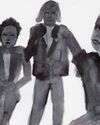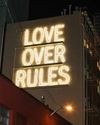
A Decade Ago, when I lived in Berlin, I would often detour from my daily run through Tiergarten, the city’s appealingly untended park, to visit certain buildings I felt drawn to for reasons I couldn’t name. These were largely (though not exclusively) midcentury dwellings — some neglected, others wildly overgrown — on or in the park that seemed to reify my sense of the city’s layered strangeness, of its mystery and opportunity for discovery. Even more than other European cities, Berlin is marked by the remains of all kinds of ideologies past, from the TV Tower in the vast main square, Alexanderplatz, a retro-future icon erected in the late 1960s by the East German government in a now poignant display of might, to the buildings the Nazis left behind. (Hitler never did fully realise his vision of a rebuilt Berlin as the capital of “Germania,” but the kind of neo-Classical bombast he had in mind is evident in the Olympic Stadium, which he commissioned shortly after he took power in 1933 and was completed in time for the 1936 Summer Games, and the limestone Tempelhof Airport terminal, which was constructed between 1936 and 1941 and, following the war, became a site of the airlift that sustained the city with food and supplies when Stalin blocked access to West Berlin.) All architecture conveys a set of narratives, histories and values for how best to live, and today’s Berlin, a jumble of tragedy and utopian ambitions past — and, these days, encroaching foreign investment — can feel like an especially dark choose-your-own adventure story.
This story is from the {{IssueName}} edition of {{MagazineName}}.
Start your 7-day Magzter GOLD free trial to access thousands of curated premium stories, and 9,000+ magazines and newspapers.
Already a subscriber ? Sign In
This story is from the {{IssueName}} edition of {{MagazineName}}.
Start your 7-day Magzter GOLD free trial to access thousands of curated premium stories, and 9,000+ magazines and newspapers.
Already a subscriber? Sign In

Look At Us
As public memorials face a public reckoning, there’s still too little thought paid to how women are represented — as bodies and as selves.

Two New Jewellery Collections Find Their Inspiration In The Human Anatomy
Two new jewellery collections find their inspiration in the human anatomy.

She For She
We speak to three women in Singapore who are trying to improve the lives of women — and all other gender identities — through their work.
Over The Rainbow
How the bright colours and lively prints created by illustrator Donald Robertson brought the latest Weekend Max Mara Flutterflies capsule collection to life.

What Is Love?
The artist Hank Willis Thomas discusses his partnership with the Japanese fashion label Sacai and the idea of fashion in the context of the art world.

The Luxury Hotel For New Mums
Singapore’s first luxury confinement facility, Kai Suites, aims to provide much more than plush beds and 24-hour infant care: It wants to help mothers with their mental and emotional wellbeing as well.

Who Gets To Eat?
As recent food movements have focused on buying local or organic, a deeper and different conversation is happening among America’s food activists: one that demands not just better meals for everyone but a dismantling of the structures that have failed to nourish us all along.

Reimagining The Future Of Fashion
What do women want from their clothes and accessories, and does luxury still have a place in this post-pandemic era? The iconic designer Alber Elbaz thinks he has the answers with his new label, AZ Factory.

A Holiday At Home
Once seen as the less exciting alternative to an exotic destination holiday, the staycation takes on new importance.
All Dressed Up, Nowhere To Go
Chinese supermodel He Sui talks about the unseen pressures of being an international star, being a trailblazer for East Asian models in the fashion world, and why, at the end of the day, she is content with being known as just a regular girl from Wenzhou.